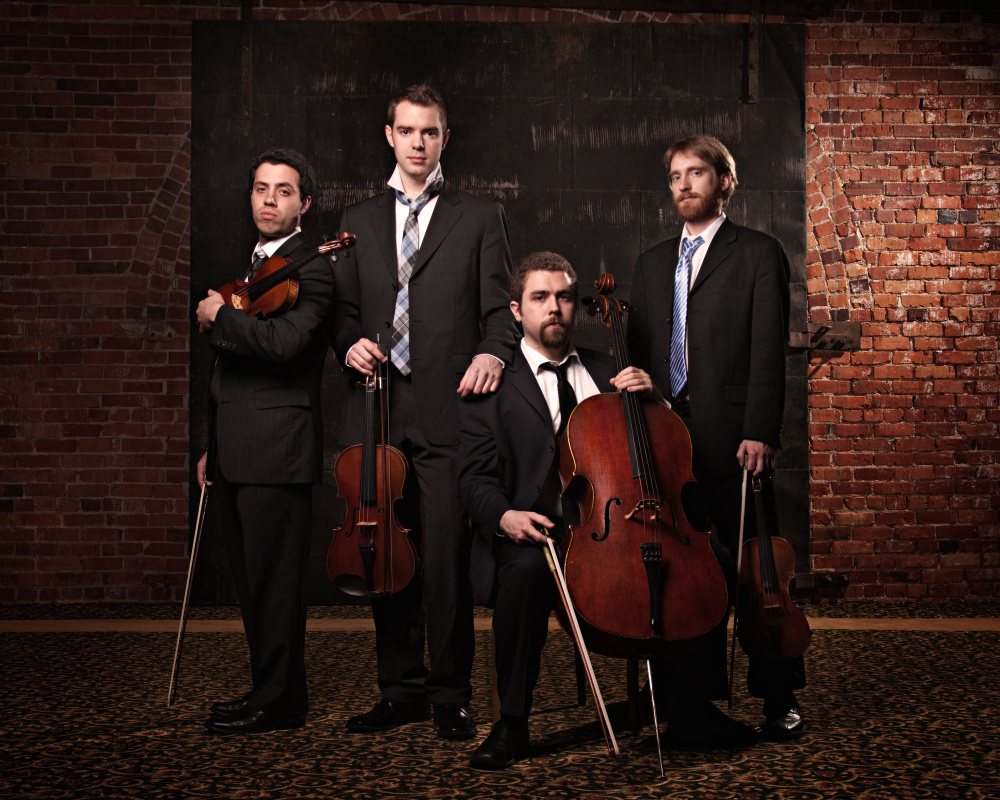By ALLAN KOZINN
BRUNSWICK – The Bowdoin International Music Festival has been devoting its Monday evenings to performances by visiting string quartets, and on Monday the spotlight fell on the JACK Quartet, which in recent years has rivaled the Kronos and Arditti quartets for supremacy in the string quartet division of the new-music world. Its name is an acronym built of the initials of the founding players’ first names – violist John Pickford Richards, violinists Ari Streisfeld and Christopher Otto, and cellist Kevin McFarland.
But the group, which has performed together since 2007, is in transition at the moment: After a performance in Colorado on Aug. 5, Streisfeld is leaving the group to take a university position, and McFarlane is departing to spend more time composing. (Their successors are violinist Austin Wulliman and cellist Jay Campbell.)
If there is one program for which the mysterious title of this year’s festival – “(Re)invention” – makes sense, this is it. Interspersed among recent scores by Derek Bermel and Caroline Shaw, and a contemporary classic by Iannis Xenakis, the JACK players performed their own arrangements of works by the medieval composers Machaut and Rodericus, who flourished in the 14th century, and the eccentric Baroque master Gesualdo, who straddled the 16th and 17th centuries.
Because Machaut and Rodericus composed long before the harmonic conventions of Western classical music were established, their music has an otherworldly quality that makes them sound antique and modern at the same time. And Gesualdo embraced expressive dissonance so freely – and in ways so unlike those of his contemporaries – modern composers have regarded his as a kindred spirit.
All these ancient works were originally vocal music. In the case of the Machaut, arranged by Streisfeld, they were two French chansons and a Latin sacred piece, but if the association between text and music was inevitably lost, the quartet version put a welcome spotlight on the clarity of Machaut’s polyphony and the ingenuity of his rhythmic techniques. And although the quartet played largely without vibrato, in deference to the presumed style of Machaut’s time, the players took a thoroughly modern approach to tone color and dynamics.
They approached three Gesualdo madrigals (also arranged by Streisfeld) and Rodericus’ only known work, the intensely polyrhythmic “Angelorum Psalat” (arranged by Otto), in much the same way, giving these distant scores a lively, updated – you could say reinvented – sound.
There are direct links between these oldies and Shaw’s “Ritornello” (2012). Shaw, who won a Pulitzer Prize in 2013, wrote the piece for voices (specifically, her vocal group, Roomful of Teeth) and arranged it for quartet in 2013. And she based the score on harmonic progressions borrowed from the Baroque composer Monteverdi.
It is an extraordinary piece. Although Monteverdi’s music is rarely quoted directly (apart from a section that sounds like a sped-up version of the rising chords at the end of “Il combattimento di Tancredi e Clorinda”), Shaw’s allusions to his harmonic world give the piece a heavenly sound, magnified by her fluid approach to tonality and color. Rich-hued bowed writing gives way to vibrant pizzicato sections and then rumbling strumming and bent-note passages in a lengthy score full of pleasant surprises.
Bermel’s “Intonations” (2016) was written for the group and had its premiere last month at the New York Philharmonic biennial. Inspired by a rereading of Ralph Ellison’s 1952 novel, “The Invisible Man,” the work evokes the atmosphere of Ellison’s sound world – that of jazz, blues and film scoring touches of the 1940s and ’50s, all refracted through Bermel’s own 21st-century sensibility.
Its opening movement, “Harmonica,” captures the blown and drawn chordal sound of the instrument it is named for, but only for a moment: Bermel quickly moves toward jazz rhythms and film noir allusions. The central movement, “Hymn/Homily,” begins on a mournful, sour note, but expands energetically. And “Hustle,” the finale, molds grand, dissonant chords into vehement speech rhythms, which in turn melt into expansive, curving lines.
Xenakis’s “Tetras” (1983) is an unabashedly noisy score, a 20-minute essay in crunching, sliding, slapping, popping, scratching and creaking sounds, and dense, furious rhythms that often make it seem more like an electronic piece than quartet work. If you want narrative coherence, this is not the place to look. But as an overview of the modern quartet’s possibilities, it is hard to top, and you are not likely to hear a more energized reading than JACK delivered.
Allan Kozinn is a former music critic and culture writer for The New York Times who lives in Portland. He can be contacted at:
allankozinn@gmail.com
Twitter: kozinn
Send questions/comments to the editors.



Comments are no longer available on this story